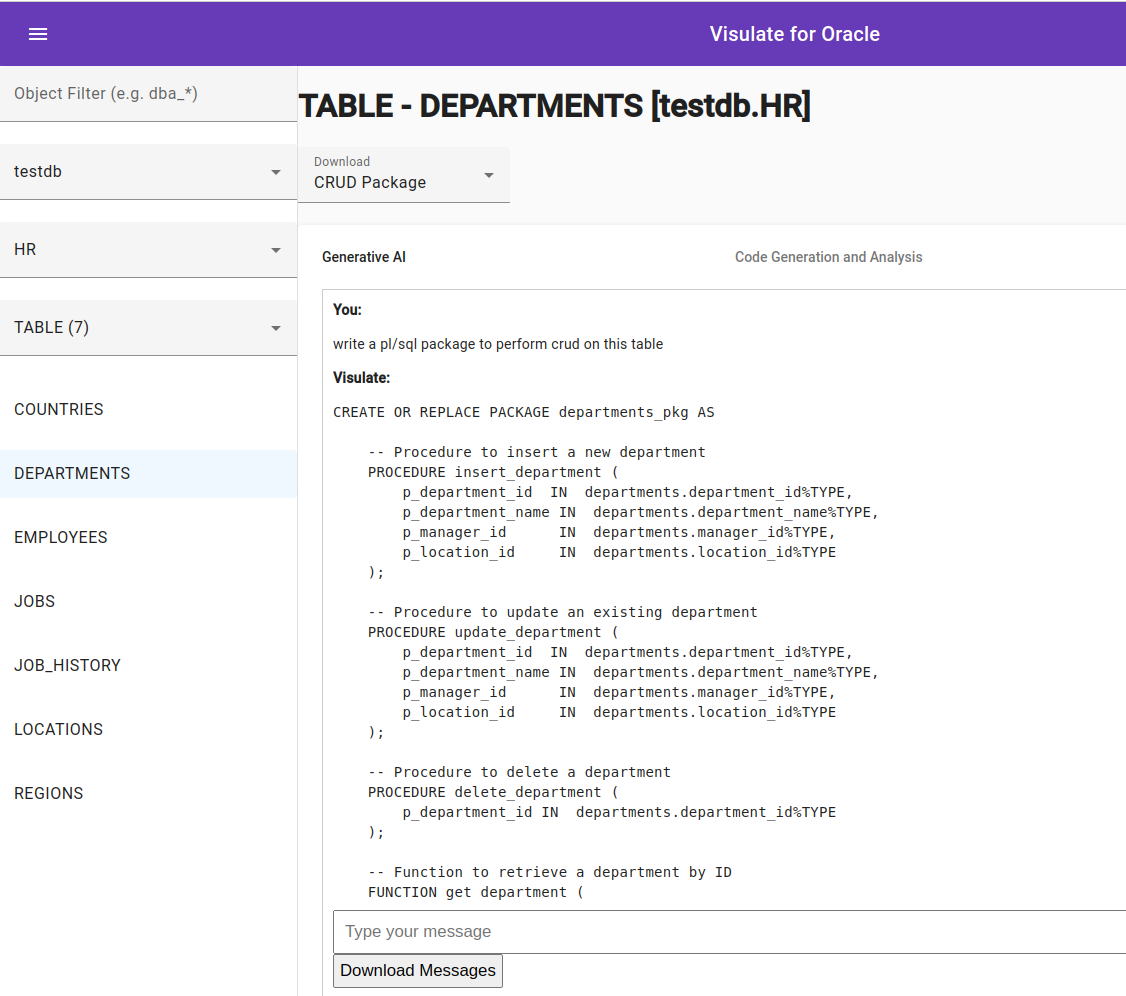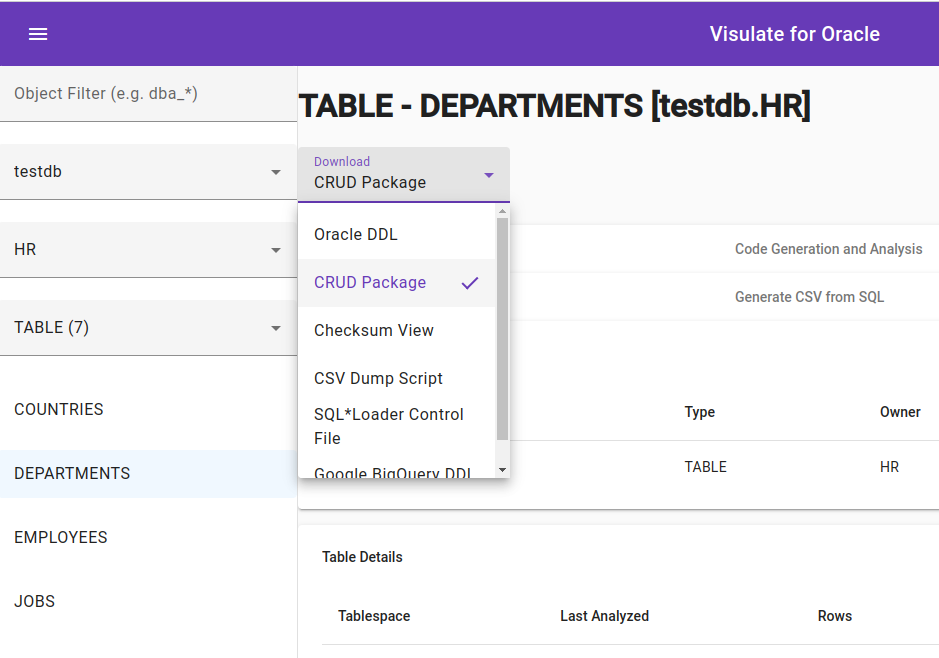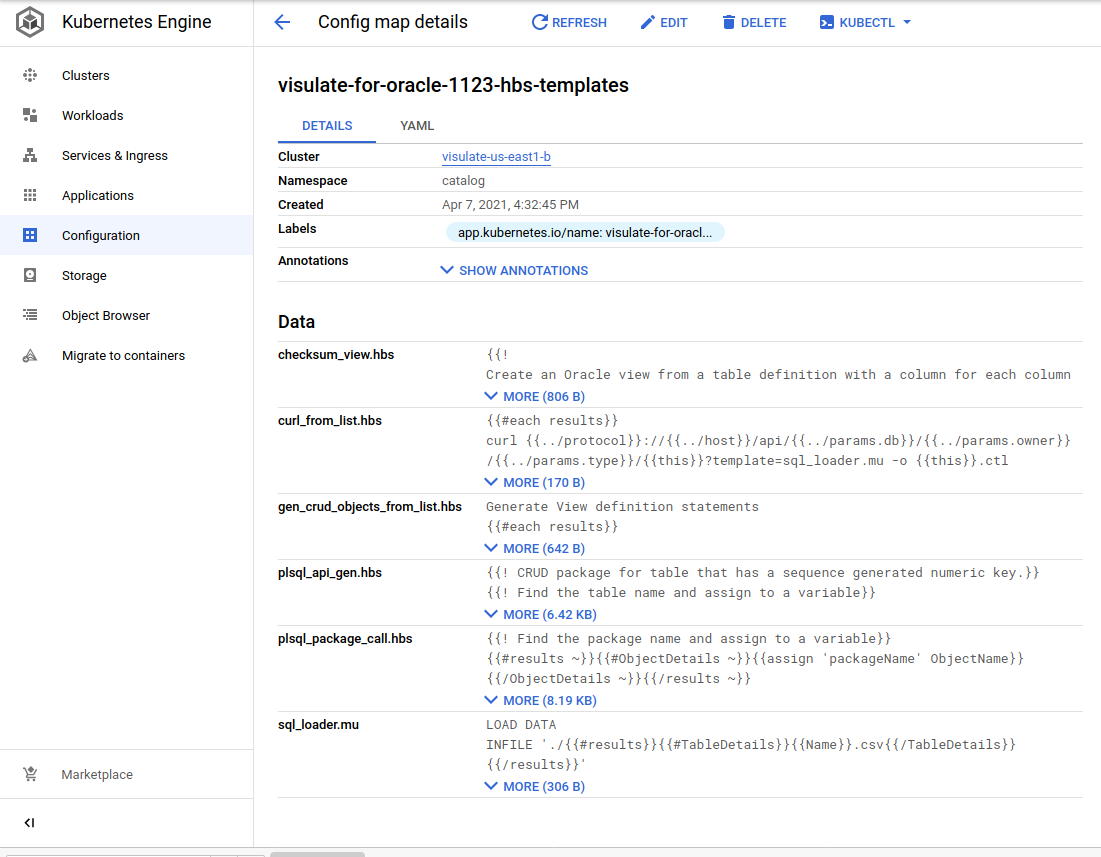Code Generation
Visulate provides 2 mechanisms for code generation:
- Generative AI
- Template driven
Generative AI
Generative AI code generation uses a large language model (LLM) to generate code based on the metadata for a given database object. Visulate sends this metadata to the LLM along with a user request in a chat window as shown in the example below:

The chat window allows the user to interact with the LLM and request refinements to the generated code. A Download Messages button allows the result to be saved to a text file.
Template Driven
Template driven code generation uses handlebars templates to transform database metadata into code. The result can be accessed via a drop down in the UI or an API call

Default Templates
The Visulate application delivers a set of sample templates via a config map called App instance name-hbs-templates.

| Template Name | Description |
|---|---|
| plsql_package_call.hbs | Generate code to call procedures and functions in a PL/SQL package |
| plsql_api_gen.hbs | Generate a PL/SQL package to handle create, retrieve, update and delete operations for a given table |
| checksum_view.hbs | Create an Oracle view from a table definition with a column for each column in the table plus a checksum column based on values for the columns. Used in web forms to detect changes in tables that do not have audit columns. |
| curl_from_list.hbs | Generate curl statements from a list of objects |
| gen_crud_objects_from_list.hbs | Generate plsql_api_gen API calls for a list of tables |
| generate_csv_files.hbs | Generate a shell script to download CSV files for a list of tables |
| sql_loader.mu | Mustache template to generate a SQL*Loader control file |
User defined templates
The database object and object list APIs include an optional template parameter. It accepts the name of a handlebars or mustache template. This template is used to transform the API’s result set.
Example
Passing plsql_package_call.hbs to the template parameter for a PL/SQL package will transform the JSON document that the API returns into a plain text response with the PL/SQL code to call the public functions and procedures in the package:

curl -X GET \
"https://catalog2.rmgr.com/api/rmg119/WIKI/PACKAGE/RNT_MENUS_PKG?template=plsql_package_call.hbs" \
-H "accept: application/json"
Responds with:
/**************************************************************
API Calls
***************************************************************/
-----------------------------------------------------
-- GET_CHECKSUM
-----------------------------------------------------
GET_CHECKSUM_VALUE := RNT_MENUS_PKG.GET_CHECKSUM
( X_TAB_NAME => -- IN VARCHAR2(32)
, X_MENU_NAME => -- IN VARCHAR2(32)
);
-----------------------------------------------------
-- UPDATE_ROW
-----------------------------------------------------
RNT_MENUS_PKG.UPDATE_ROW
( X_TAB_NAME => -- IN VARCHAR2(32)
, X_MENU_NAME => -- IN VARCHAR2(32)
, X_MENU_TITLE => -- IN VARCHAR2(32)
, X_DISPLAY_SEQ => -- IN NUMBER(22)
, X_CHECKSUM => -- IN VARCHAR2(4000)
);
-----------------------------------------------------
-- INSERT_ROW
-----------------------------------------------------
RNT_MENUS_PKG.INSERT_ROW
( X_TAB_NAME => -- IN VARCHAR2(32)
, X_MENU_NAME => -- IN VARCHAR2(32)
, X_MENU_TITLE => -- IN VARCHAR2(32)
, X_DISPLAY_SEQ => -- IN NUMBER(22)
);
-----------------------------------------------------
-- DELETE_ROW
-----------------------------------------------------
RNT_MENUS_PKG.DELETE_ROW
( X_TAB_NAME => -- IN VARCHAR2(32)
, X_MENU_NAME => -- IN VARCHAR2(32)
);
end;
/
Copyright © Visulate LLC, 2019, 2025 Privacy Policy